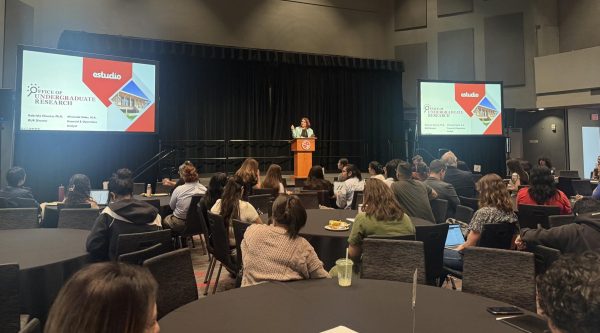Student research programs persist despite defunding
Students across CSUN gathered on Sept. 26 for the Office of Undergraduate Research (OUR) annual Getting Into Research event. The event aimed to encourage students to dive into research early on, highlighting opportunities available to undergraduates.
“There are funding opportunities, so if you are looking for a job to fit your class schedule, why not do research?” said Kristina Meshelski, chair of the philosophy department. “It’s an opportunity that you might only have in college, so it’s a really good time to explore.”
Held in the Northridge Center Complex in the University Student Union (USU), faculty members were able to present their research programs and recruit undergraduate students to their projects. The presentations included the SECURE for Students Success Program (SfS2), the Institute for Sustainability, Autonomy Research Center for STEAHM and the Department of Philosophy.
S.K. Ramesh, the program director of SfS2, said the program is open to CSUN students and partnering community colleges like College of the Canyons and Pierce College. SfS2 is funded through a Title V Developing Hispanic Serving Institutions (DHSI) grant. However, the Department of Education announced on Sept. 10 that it will be discontinuing funding for HSIs.
Despite this news, Ramesh ended his presentation with “Kaitiakitanga,” a Māori phrase which he explained means “care for your environment, your country and your future.”
Director of the Institute for Sustainability Sheila Steinberg shared the program’s initiatives for creating a sustainable San Fernando Valley. Their goal, according to Steinberg, is positioning the university “as a hub for regional sustainability solutions,” which would be achieved through help from the student-led Sustainability Action Team.
Steinberg expressed her desire to use indigenous and local knowledge to promote sustainability in Northridge and hopes to bring support to local businesses.
“Don’t go to Hollywood, come to Northridge!” Steinberg said.
There were also many non-STEM related research opportunities, which some students at the event were surprised by.
“I didn’t know there was this much opportunity here,” said junior linguistics major Jordan Banuelos. “I thought that it was going to be mostly for students within the disciplines that each presenter is representing, but that’s not the case.”
The organizers of OUR are aiming to integrate more student research opportunities from non-STEM faculty and programs.

“I would love to get more art, theater, humanities and education,” said OUR Director Gabriela Chavira. “But it’s something that is not traditional in terms of their field. We need to do more in helping them learn how to involve students in their research projects.”
There were a few presentations from the child development and humanities disciplines, including Professor Jo Anne Pandey’s research on Kathmandu Municipality City School system’s Book Free Friday initiative, an alternative education program in Nepal, which is available for students interested in child development research.
All student research will be done in Southern California, while Pandey will go to Nepal from Dec. 2025 to Jan. 2026.
Pandey has been doing work in Nepal since 1992. After the 2015 earthquake, Pandey worked with Nepali teachers to train them to create a classroom-based writing therapy curriculum with students who survived the tragedy. Pandey acknowledged that the recent Nepal uprising has brought about uncertainty in what student research will look like, but she will be integrating the situation into the project.
The Department of Philosophy promoted its annual student conference, which happens in the spring semester. Meshelski encouraged students from any discipline to submit a research project.
“For my department, I just want to bring students into anything philosophy related, even if they just take a philosophy class,” Meshelski said.
The event has been successful in connecting students with faculty and creating an environment where both parties can benefit from each other on their projects.
“Dr. Stefanie Drew, she brought her two students that she met last year at this very event, and they’re now involved in her research,” said Chavira. “We have many of these stories where I’ve heard, ‘I met my student through the getting into research event last year or the year before.’”
Students can get more information about OUR and their opportunities on their website and at the University Library.
Latest Daily Sundial
- Visa costs deter international musicians from touring the USWhen a band posts an intricately designed tour poster on Instagram, fans flock to the comment section. Many excitedly proclaim which date they will attend, but there is an inevitable...
- CSUN divided as Gaza anniversary protest leads to student arrestThe two-year mark of the conflict in Gaza sparked demonstrations at CSUN from both sides of the movement. Over 100 pro-Palestinian and pro-Israeli students walked out of their classes and...
- CSUN men’s soccer ends in draw against Sacramento StateCSUN’s men’s soccer team hosted Sacramento State in a Big West Conference Matchup. CSUN started the game strong, scoring two goals in the first half, dominating the Hornets. SAC State,...
- CSUN falls to UCLA in back-and-forth ice battleThe CSUN Ice Hockey team welcomed UCLA in the first of two back-to-back matches at their home rink at the Iceoplex in Simi Valley. The Matadors and Bruins tied in...
- Matadors dive into the fun of Poolside DJPoolside DJ is an event that unites Matadors at CSUN’s recreational pool once a semester. This time around, the event featured a live set from DJ Le Chef, an arts...
- Weekend Recap: Inconsistency costs the Matadors at Visit Stockton Pacific InvitationalThe CSUN men’s golf team wrapped up the Visit Stockton Pacific Invitational with an 11th-place finish at The Reserve at Spanos Park in Stockton. Across three rounds, the Matadors posted...






